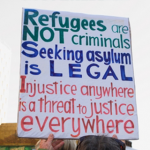Protecting Detainees: An Interview With Victorian Ombudsman Deborah Glass

The Australian government ratified the Optional Protocol to the Convention against Torture on December 15. Better known as the OPCAT treaty, the international agreement aims to prevent the abuse and mistreatment of people in detention.
The treaty builds upon the 1984 United Nations Convention against Torture. The Australian government signed the OPCAT back in May 2009. But, it’s taken a further eight years for it to consent to be legally bound by the agreement.
Under the OPCAT, Australia has to enhance oversight of its places of detention, as well as improve the conditions at these facilities. These closed environments include prisons, juvenile detention centres, secure mental health facilities and immigration detention centres.
How the OPCAT operates
Australia is now obligated to open its detention facilities to regular independent inspections. The government has agreed to establish local inspection bodies called National Preventive Mechanisms (NPMs).
These inspectorates will carry out random unannounced visits to detention facilities to protect people deprived of their liberty against mistreatment. NPMs will make recommendations to relevant authorities, and will also conduct confidential interviews with child detainees.
The protocol further provides that the UN Subcommittee on the Prevention of Torture (SPT) will undertake inspections of places of detention in Australia. Made up of 25 independent experts, this international body will then make recommendations to the Australian government.
However, the OPCAT won’t better conditions in Australian offshore detention centres, as neither the local or international inspection bodies will have the right to inspect these facilities.
Youth detention
Human rights abuse issues in Australia’s youth justice system have come to the fore recently. The Royal Commission into the protection and detention of children in the Northern Territory tabled its report in November.
The report outlined that “the systems failed to comply with the basic binding human rights standards in the treatment of children and young people.” The commission was established after incidents of torture at Darwin’s Don Dale youth detention centre were reported in mid-2016.
Subsequent investigations revealed the use of excessive force and prolonged isolation in Queensland’s Cleveland youth detention centre, while Tasmania’s Ashley youth facility came under scrutiny for a series of incidents that were perpetrated upon teenagers by youth justice officers.
But, if the OPCAT treaty had already been in place, then these juvenile facilities would have been subjected to random inspections, which could have led to certain practices being scrutinised, and ongoing right abuses being prevented.
An inspection by OPCAT standards
After the federal government announced it would ratify the OPCAT treaty in February last year, Victorian Ombudsman Deborah Glass conducted a seven day investigation of the Dame Phyllis Frost Centre: Victoria’s main women’s prison.
Twelve members of her staff assessed the conditions and practices at the correctional facility against the standards of the OPCAT treaty. The aim of the investigation was to gauge whether the Victorian system is prepared to respond to its new international obligations.
The Ombudsman report was released in late November.
Sydney Criminal Lawyers® spoke to Ms Glass about what the prison inspection revealed, whether the system in Victoria is able to meet OPCAT levels of compliance, and the benefits of adhering to a system like the OPCAT for the community as a whole.
Firstly, Ms Glass, your office undertook an independent inspection of the Dame Phyllis Frost Centre in July last year. Your staff assessed the facility against the standards of the OPCAT treaty.
How did you find conditions at the prison?
Overall, we found a facility undergoing significant change. This is, sadly, not surprising – the number of women in the prison has grown by over 60 percent in the last 5 years and the number of remand prisoners has more than doubled.
While a major expansion is underway, the strains were evident during our inspection, with the physical conditions of some of the units notably bleak. While some aspects of the prison were working well despite these pressures, we also identified a number of areas of concern.
And what were some of the specific issues that you did find were taking place at the women’s correctional facility?
We were concerned about the excessive use of force and restraint, such as pregnant women being routinely handcuffed when attending external medical visits, and several instances of prolonged solitary confinement.
We were also concerned about the prison’s practice of routinely strip searching women before and after contact visits, which in my view is a breach of the Victorian Charter of Human Rights.
Although this practice is intended to prevent contraband entering the prison, it is plainly not effective in doing so, and it is humiliating, degrading and undignified.
When we checked the records, we identified that only four of 148 contraband items seized in 2016-17 were found in the visits centre. Only one of those involved drugs – half a blood pressure tablet.
As I said in my report, drugs and contraband are clearly entering the prison through other means.
Now, your report made 19 recommendations to the Victorian Department of Justice and Regulation to reduce the risk of cruel, inhuman and degrading treatment at the facility.
What were some of these recommendations? And how did the department respond to them?
The department accepted 18 of my 19 recommendations, which included implementing strategies to minimise the use of force and restraint, replacing the management unit, and engaging clinical and human rights expertise in relation to the long-term use of separation.
The one recommendation not accepted was to stop the practice of routine strip searching.
So, the department refused to abolish the practice of strip searching the detainees, which was one of your office’s greatest concerns about the prison’s policies.
Do you think the department would have reacted differently to the recommendation if it was being made by a local NPM, or the international SPT, officially under the provisions of the OPCAT.
I doubt it. While we do not yet have an NPM structure in place, the Ombudsman has the necessary powers of an NPM, including the statutory power to make recommendations, and the power to monitor and report.
Recommendations are never enforceable other than through the power of public persuasion, and Ombudsmen and other NPMs around the world, where OPCAT has been ratified, have varying degrees of success in relation to implementation.
As far as my own recommendations are concerned, the acceptance rate stands at 95 percent, and I will continue to monitor and report publicly on progress.
So, your office carried out this inspection under the standards of an OPCAT inspection.
What sort of problematic conditions and practices are OPCAT inspectors specifically looking for when investigating a detention facility?
A key feature of OPCAT inspections is that they should be preventative – focussing on identifying risk factors and protective measures to prevent abuses in the future. The Association for the Prevention of Torture advises that OPCAT inspections should emphasise “co-operation, not condemnation.”
In our inspection we developed a number of tools, including a survey of prisoners and staff, and aide-mémoire on the key areas covered by the Nelson Mandela Rules – the main international standards regarding the treatment of prisoners – which include humane treatment, protective measures, health and wellbeing, material conditions and purposeful activity.
The purpose of your inspection was to ascertain whether the Victorian system is prepared to respond to its international obligations under the OPCAT treaty.
In your opinion, is the system in your state ready to cope with the new levels of compliance it must meet?
I think Victoria can be ready relatively quickly. The government will need to decide which independent body or bodies it designates as NPMs, and ensure those bodies have both the resources and the powers to do the job.
Some people in the community are of the belief that once a person has broken the law and been sent to prison, they forgo much of their rights. These people would question why a system is being put in place to uphold the rights of prisoners.
How would you respond to these lines of thought from people who may question the need for a system like OPCAT?
Let me first quote Nelson Mandela, who said that a nation should not be judged by how it treats its highest citizens, but its lowest ones. How we treat prisoners is a mark of our civilisation, and preventing abuses in detention is simply the right thing to do.
But OPCAT also has important practical benefits. Inspections help to ensure the effectiveness of prisons in promoting rehabilitation, which in turn reduces recidivism and increases community safety.
They can identify pressure points which if left unchecked, can result in riots. It costs far more to deal with the consequences of ill-treatment – such as a huge bill for damage or compensation – than setting up regular monitoring to prevent it.
And lastly, over recent years, there’s been a lot of focus upon rights abuses in Australian detention facilities, especially in regard to youth detention, and the detention of asylum seekers.
What sort of improvements and changes do you foresee the government’s ratification of the OPCAT treaty will bring to onshore detention facilities that operate in this country?
I very much hope we will no longer see such instances of rights abuses in detention. A mark of OPCAT’s success may well be the absence of headlines.







